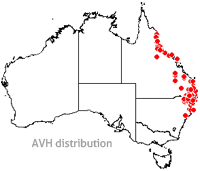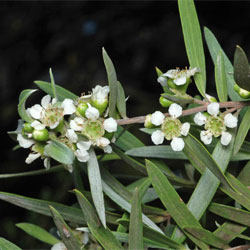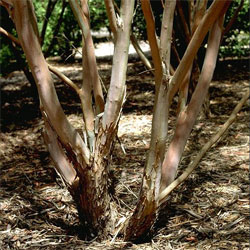Leptospermum brachyandrum
a teatree
Leptospermum brachyandrum (F.Muell.) Druce
 Leptospermum brachyandrum is a member of the Myrtaceae family. Though there currently is no common name for this particular species, “Tea tree” is the generic name for members of its genus.
Leptospermum brachyandrum is a member of the Myrtaceae family. Though there currently is no common name for this particular species, “Tea tree” is the generic name for members of its genus.
This species’ natural range extends from just north of Port Macquarie in New South Wales up towards northern Queensland. Though this plant’s ideal environment seems to be beside creeks and rivers where it is frequently inundated for lengthy periods during the summer months, there are some populations in Queensland that grow far from waterways on steep, rocky slopes.
Leptospermum brachyandrum becomes a large shrub or small tree, reaching up to 5m. It usually prefers growing on sites with wet soil that have part shade to full sun. However, some plants in cultivation have been known to grow quite happily in much more free draining soils. The leaves are linear-lanceolate in shape and reach approximately 5 cm in length. The white flowers have a diameter of 7 mm and cluster around the ends of the branches. The white flowers are open to see in late spring and early summer with the fruit capsules developing soon after the flowering season.
The soft pink, grey and copper shades on the inner bark surface that is revealed after the seasonal moulting of its outer bark makes this plant a delightful specimen plant or landscape feature for gardens. Another plus side to this species is that it is bird attracting, often drawing in Wattle birds and small honeyeaters. The fact that it is very easy to propagate, whether it be done using cuttings of half-ripened tips or by seed is yet another favourable feature of this species. It is also quite frost hardy, having survived temperatures as low as -7°C.
When considering the Leptospermum genus there are a couple of pests to look out for. One is the webbing caterpillar. Usually the most effective control method for this pest is removing infestations by hand or, if necessary, you can systematically spray with a pesticide. Another important pest is scale insects. It is treated by spraying white oil solution.
Leptospermum brachyandrum has much to offer to horticulture due to its highly desirable features, including its highly distinctive trunk, the fact that it is bird attracting and is relatively easy to propagate, and lastly because it is quite frost hardy.
Text by Blake Kuiper (2012 Student Botanical Intern)
Name Meaning: Leptospermum brachyandrumLeptospermum— derived from the Greek words leptos which means fine or slender and, sperma which means seed. brachyandrum — from the Greek words brachy, which means short, and andrus which means male, referring to the rather short stamens on the male part of the flower. |
References
Australian National Botanic Gardens (ANBG) (2012) Family Myrtaceae. Available at http://www.anbg.gov.au/PLANTFAM/AUST1C.HTM. [Accessed February 2012].
Australian National Botanic Gardens (ANBG) (2012) Leptospermum brachyandrum. Available at http://anbg.gov.au/leptospermum/leptospermum-brachyandrum.html [Accessed February 2012].
Australian Native Plant Society (Australia) (2009) Leptospermum and its Relatives — Cultivation. Available at http://anpsa.org.au/leptos3.html [accessed February 2012].
Thompson, J. & Logan, V. (2012) Leptospermum brachyandrum, The Plant Information Network System of The Royal Botanic Gardens and Domain Trust, Sydney, Australia (version 2.0). Available at http://plantnet.rbgsyd.nsw.gov.au/cgi-bin/NSWfl.pl?page=nswfl&lvl=sp&name=Leptospermum~brachyandrum [Accessed February 2012].
Wrigley, J.W. & Fagg, M. (1993) Bottlebrushes, Paperbarks & Tea Trees: And all other plants in the Leptospermum alliance. Angus & Robertson, Australia.
![An Australian Government Initiative [logo]](/images/austgovt_brown_90px.gif)



